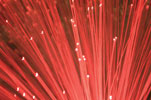

Fibre-optics can be used for more than data transmission.
Fibre-optic sensing technologies use the capability of fibre-optic signal parameters to respond to movement, vibration and noise impacted on optical fibre cables over a long distance.
Analysing the optical signal to detect the location of these events along the length of the fibre cable allows users to discriminate between true intrusion signals and environmental noise signals. This provides a technology for detecting and locating third-party intrusions for oil or gas pipelines, processing facilities and data networks, thereby helping to protect the security and integrity of the client’s assets.
Pipeline applications for fibre-optic sensing technologies comprise the detection of intentional, accidental and natural events which may impact the security and integrity of buried oil or gas pipeline operations.
A fibre-optic communication and control system backbone cable installed in the buried pipeline trench provides the optical fibre sensor along the length of the pipeline. Up to 50 km of pipeline distance with a typical location accuracy of about 50 m can be monitored by a single intrusion sensing controller which is installed within a pipeline station building. Multiple intrusion sensing controllers are networked together for longer pipeline distances. The intrusion sensing controllers contain the optical signal sensing and analysis technology which enable the system to be optimally tuned and calibrated for hard and soft ground conditions, pipeline and cable depths, mechanical and manual excavation activities and environmental background noise.
Perimeter applications for fibre-optic sensing technologies comprise the detection of the climbing, forcing and cutting of security fences which may impact the security and integrity of processing facilities. A fibre-optic sensing cable installed on the security fence provides the optical fibre sensor along the length of the perimeter. Up to 80 km of perimeter fence with a typical detection accuracy of about 20 m can be monitored by a single intrusion sensing controller which is installed within a facility building. Multiple intrusion sensing controllers are networked together for multiple facilities. The intrusion sensing controllers contain the optical signal sensing and analysis technology which enables the system to be optimally tuned and calibrated for the type and construction of the fence, access gates and environmental background noise. Real-time detection with intelligent reporting and alarming, without any field electronics required.
Data network applications for fibre-optic sensing technologies comprise the detection and location of unauthorised interference and illegal tapping of fibre-optic networks, in real time, before data loss or damage occur. This technology can use existing approved single mode fibre-optic communications cables as the sensor, reducing the installation cost and time, yet still detect and locate an intrusion to within 25 m, regardless of the size of the network.
Security and integrity management requires an integrated and centrally managed security solution which results in faster, proactive response to alarms and events. The integration often involves data from pipeline and perimeter intrusion sensing with data from other third-party security detection technologies, including CCTV cameras, access control and pipeline integrity systems. The facility, pipeline and operations and security personnel require to share critical data so that everyone has a real-time view and potential threat. A single and seamless window to the total pipeline and processing facility operations provided by graphics, alarming, reporting, event monitoring, operator instructions and controls, enables reliable, efficient and effective actions to be implemented and communicated to management, operations and security personnel.
For more information contact FTPSA, +27 (0)41 581 1191, [email protected], www.ftpemea.com
© Technews Publishing (Pty) Ltd. | All Rights Reserved.